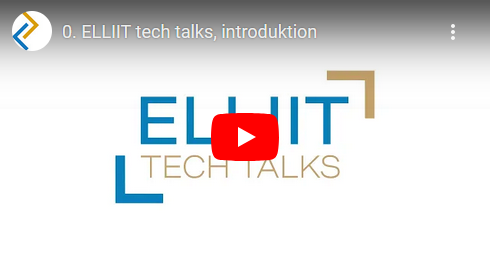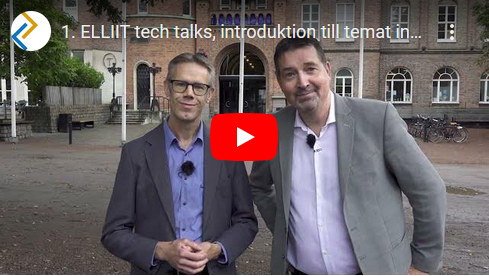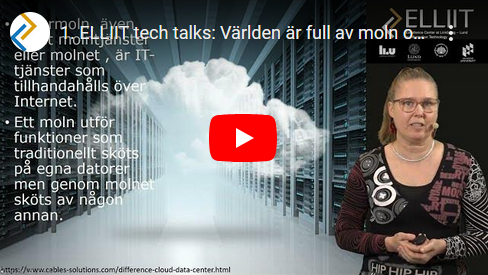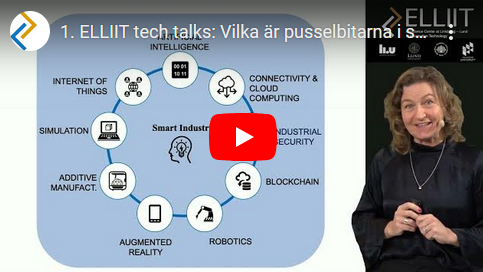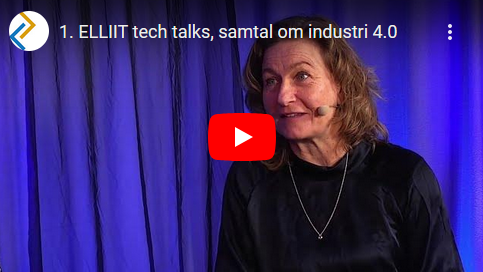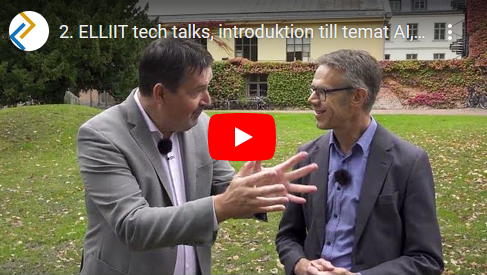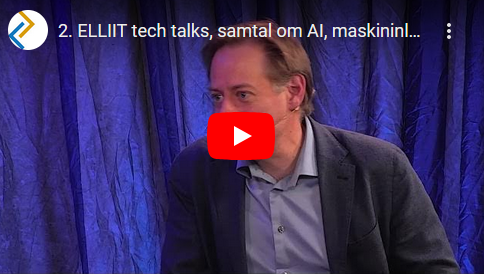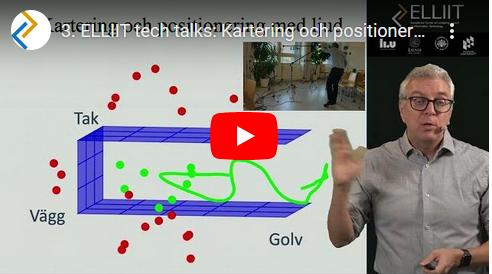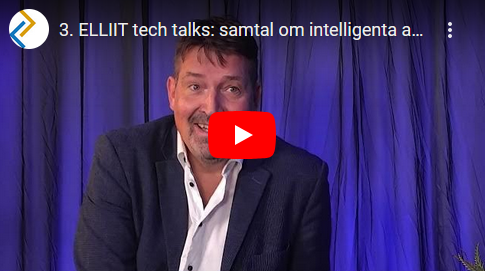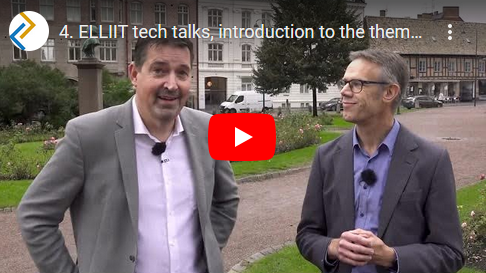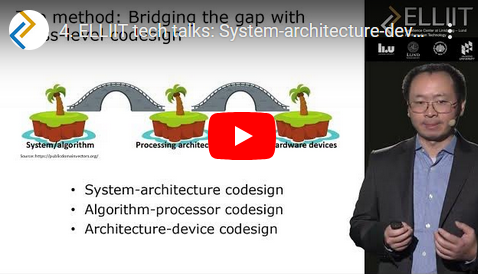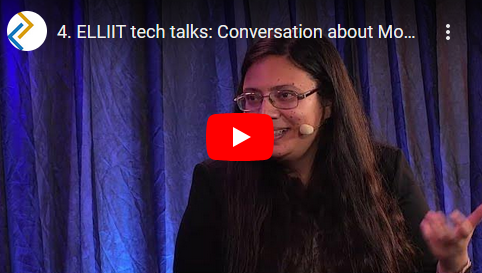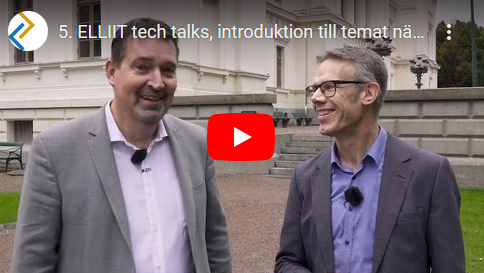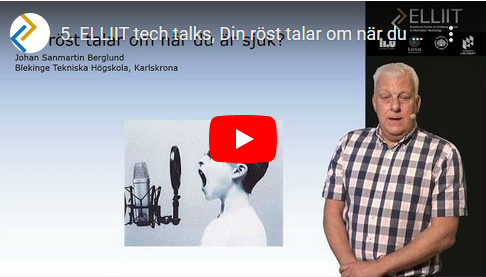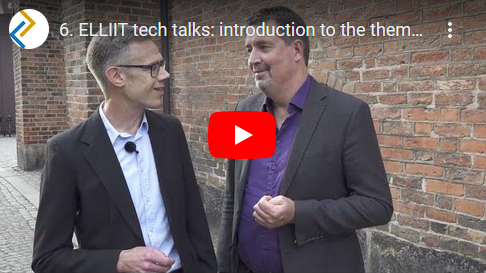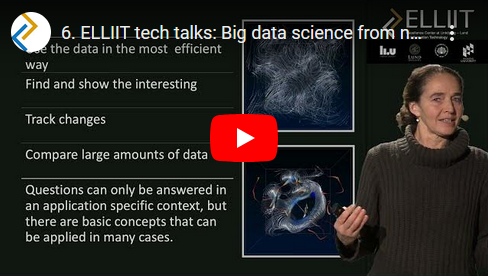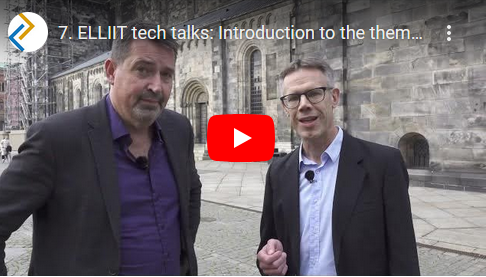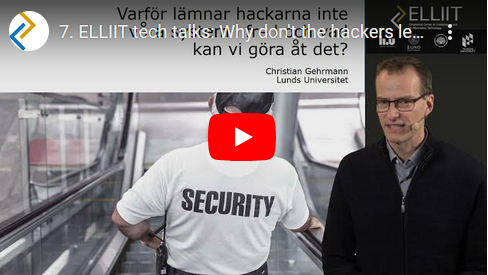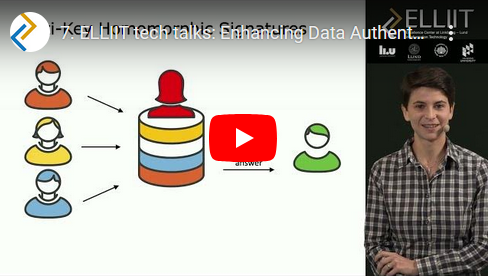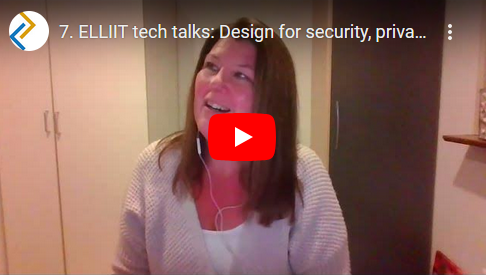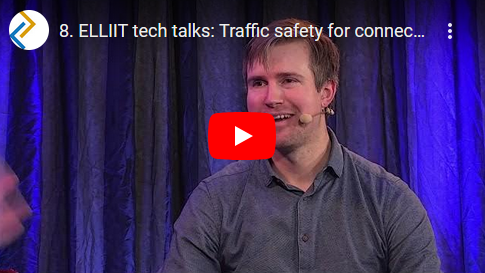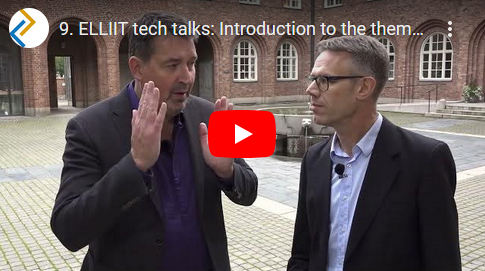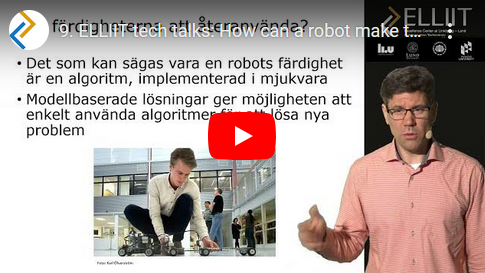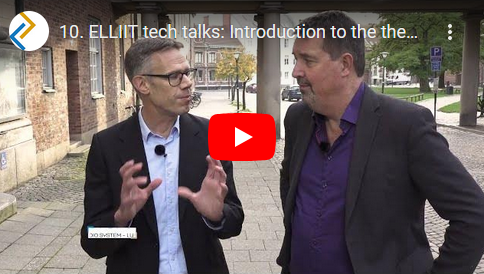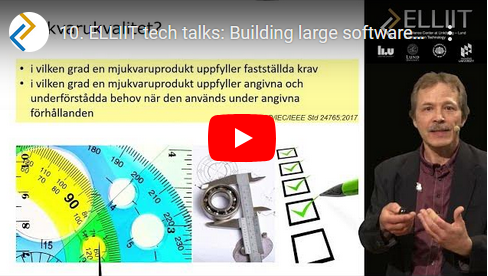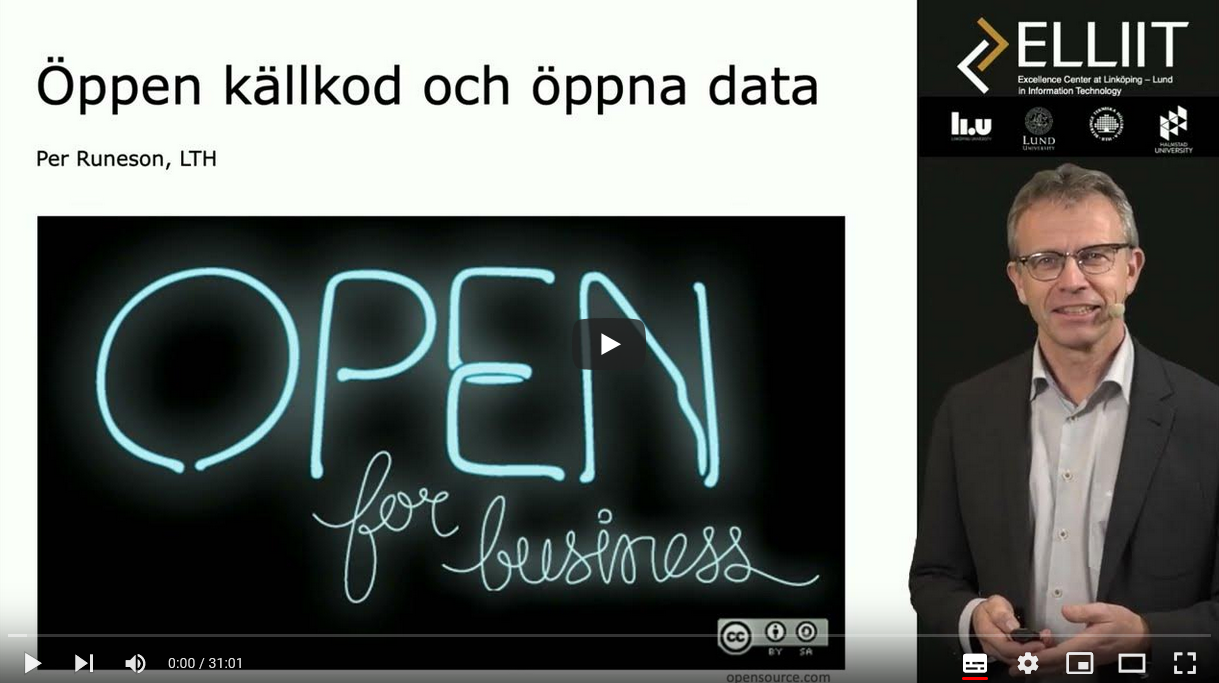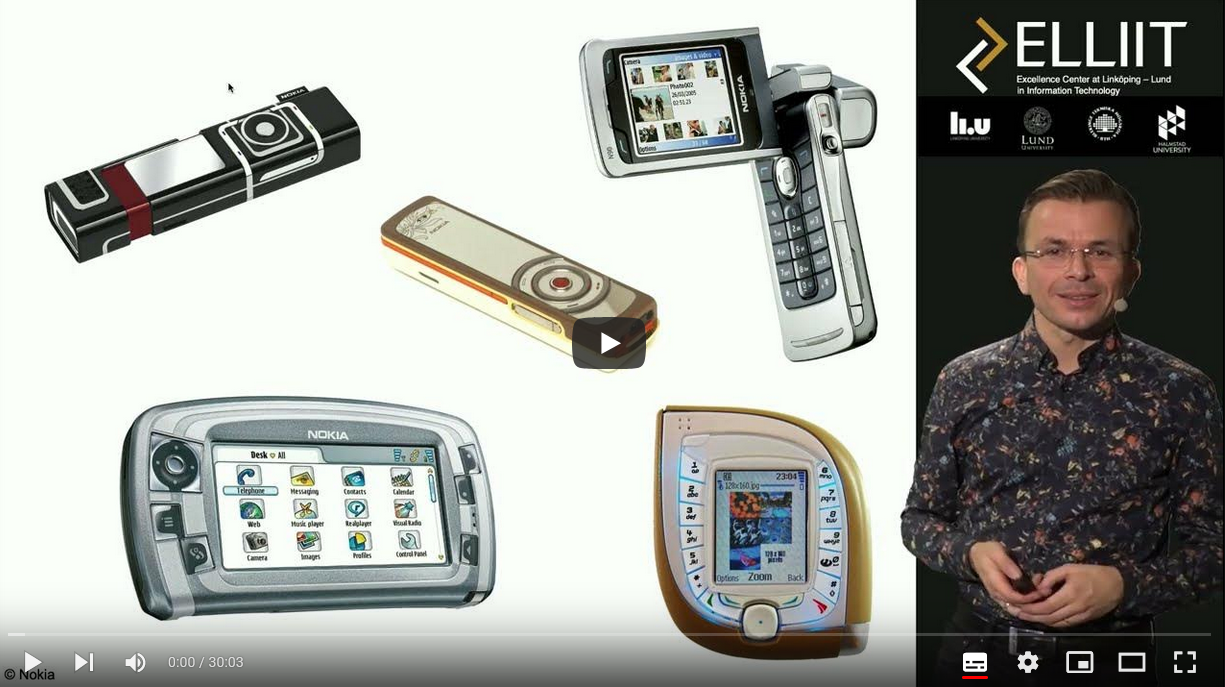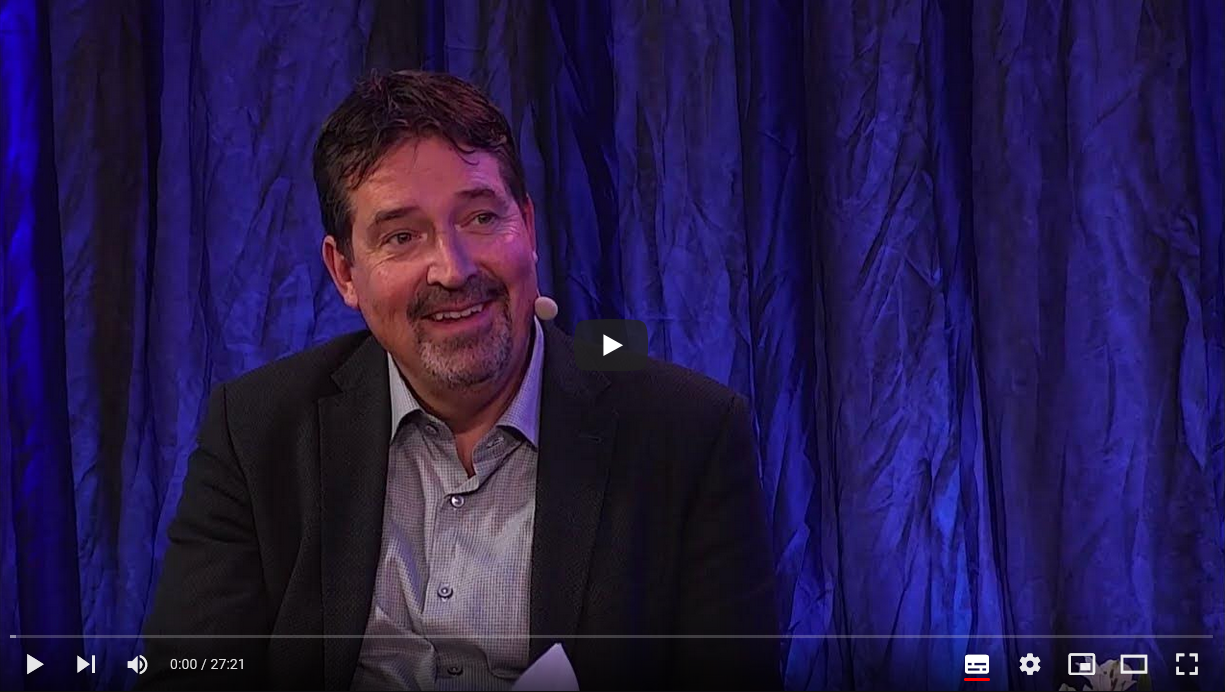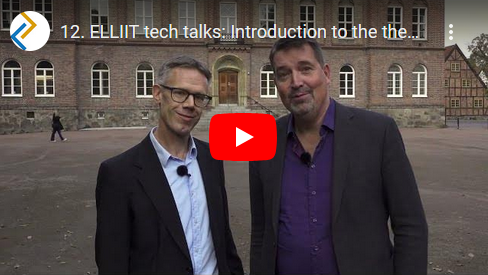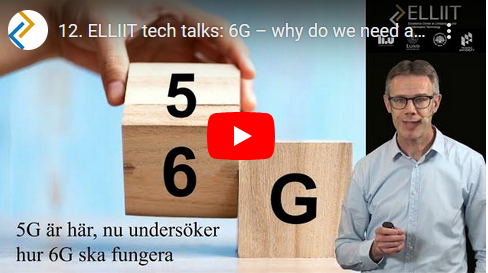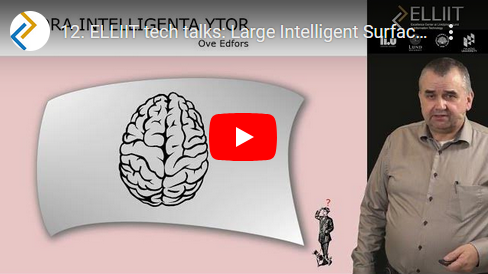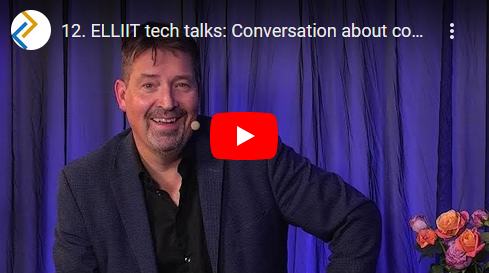ELLIIT has recorded an ambitious seminar series on digitalization and societal challenges from an ICT perspective. All four ELLIIT campuses have been involved, and the production stars the well-known Swedish research communicator and comedian Johan Wester. Topics are based on visions from the 2030 Technology Foresight.
For more information, please contact Fredrik Tufvesson, Co-director ELLIIT (fredrik.tufvesson(at)eit.lth.se)
0, ELLIIT tech talks, introduction
1. Industry 4.0
2. AI, large-scale algorithms, ML, deep learning, and XAI
3. Intelligent assistants and tools
4. Mobile processing architectures and devices
5. Next-generation software technology 1
6. Big data and network science
7. Design for security, privacy, and trust 1
8. Design for security, privacy, and trust 2
9. Autonomous vehicles and robots
10. Next-generation software technology 2
11. Digital business models and legal aspects
12. Communications and networks beyond 5G: sensors, IoT, and cloud

0, ELLIIT Tech Talks, introduction
Published 2022-10-18
Åsa Zetterberg, director TechSverige
Johan Frithiof Karlberg, CIO Lund municipality
Fredrik Tufvesson, Co-director ELLIIT
Johan Wester, host
How is the digitalization of Swedish industry going? What is happening in the public sector? Is Sweden a forerunner or not? What is needed going forward? In this episode, we give an introduction to ELLIIT tech talks, and why digitalization is vital for Sweden as a nation of knowledge and innovation.
1 Industry 4.0
Published 2022-10-18
Charlotta Johnsson, Professor of Control
Maria Kihl, Professor of Internet Systems
Jonas Birgersson, IT-entreprenur
Johan Wester, host
Charlotta Johnsson, What are the pieces of the puzzle in smart industry?
What exactly is smart industry? What are the advantages, how does it work and what are the challenges? The choice of computer between the cloud server and the smartwatch matters greatly for performance, energy consumption and privacy – for both humans and machines. We discuss design decisions and priorities.
2 AI, machine learning and large scale processing
Published 2022-11-01
Fredrik Heintz, Professor of Computer Science, LiU
Claes Lundström, Research Director, Sectra
Gunnar Cedersund, Associate Professor, Biomedical Engineering, LiU
Jonas Björk, Professor of Epidemiology, LU
Johan Wester, Host
Introduction to the theme AI, machine learning and large scale processing
Fredrik Tufvesson, Johan Wester
Fredrik Heintz, Privacy-Preserving Machine Learning
The use of AI and machine learning in different areas increase, but how can we ensure that we have ethical, reliable and privacy-preserving AI? Fredik Heintz guides us to how to avoid bias, get sufficient data for training and ensure that our privacy is preserved even when we use AI together with health data.
Gunnar Cedersund, Digital twins in health care
What exactly are digital twins, and how can we use them in the healthcare of the future? Gunnar Cedersund explains how it works. How we can make a digital model of ourselves and test different treatments on our personal artificial twin before the treatment is performed in reality.
3. Intelligent assistants and tools
Published 2022-11-15
Bo Bernhardsson, Professor of Automatic Control
Kalle Åström, Professor of Mathematics
Charlotta Falvin, Board Professional
Johan Wester, Host
Kalle Åström, Mapping and positioning with images, sound and radio
With the help of information from satellites, radio waves, images and sound, we can soon let robots catch a hair in the air, but how does it work? How can we really figure out where things are? Professor Kalle Åström explains how different positioning techniques work, what we can use them for and the mathematics behind.
Bo Bernhardsson, Navigation and radio channel estimation, – A story about a PhD Thesis
Professor Bo Bernhardsson explains radio-based navigation. We dive into the background of a doctoral thesis by the former PhD student Anders Mannesson. What does it mean to do a PhD, how does a thesis come about, what does it contain, and what was the problem that Anders solved?
4. Mobile Processing Architectures and Devices
Published 2022-11-29
Yousra Alkabani, Associate professor in computer architecture
Liang Liu, Associate professor in Integrated Circuit Design
Anders Berglund, Entrepeneur,
Johan Wester, Host
Introduction to the theme Mobile Processing Architectures and Devices
Fredrik Tufvesson, Johan Wester
Liang Liu, System-architecture-device codesign to bridge theory and practice
Associate professor Liang Liu leads us through the world of digital processing. What are the trends and requirements and how can we actually meet the processing demands of 6G and AI without running out of power using efficient techniques such as hybrid computing and in-memory computing?
Yousra Alkabani, Acceleration: From the General to the Specific
Accelerators can have many meanings, but what are accelerators for digital processing and how can we take advantage of them in order to improve performance by orders of magnitude? Associate Professor Yousra Alkabani discusses accelerators, data flow graphs and how application specific solutions can be used to meet processing requirements of the future.
5. Next-generation software technology – more than just text
Published 2022-12-13
Johan Sanmartin Berglund, Professor of Health Science
Emma Söderberg, Associate Professor of Computer Science
Sverker Sigström, Professor of Cognitive Psychology
Johan Wester, Host
Introduction to the theme Next-generation software technology – more than just text
Fredrik Tufvesson, Johan Wester
In robotics, movements have long been “recorded” and then based the programming of the robot on the recording. With machine learning and other AI techniques, steps are not being taken towards using recorded eye movements to give programmers better support in programming. With similar thinking, perhaps a future 1177 could let your voice mode reveal how you feel.
Johan Sanmartin Berglund, Your voice tells you when you are ill?
The voice can be a tool for the diagnosis of diseases. Professor Johan Sanmartin Berglund explains how we can use technical aids and AI to analyze what the voice really says about our health. By following the patient’s voice, the researchers hope to be able to follow up on treatment and control medication in a better way.
Emma Söderberg, Eye movements give us more effective programming
Software is everywhere, it grows and easily becomes complex. We need tools for building good software, tools for programmers. Associate Professor Emma Söderberg talks about software development, code review and how our eye movements can give us better programming.
6. Big data and network science
Published 2022-12-27
Zheng Chen, Assistant Professor, Communication Systems
Ingrid Hotz, Professor in Scientific Visualization
Erik G. Larsson, Professor, Communication Systems
Andreas Kristensson, Business developer Telenor
Johan Wester, Host
Fast computers, large amounts of data, machine learning, logs from large systems and smarter algorithms allow us to identify dependencies that we have never been aware of before. Dependencies that could be cause and effect and thus provide invaluable knowledge previously being invisible to us. How does it work, how do we make it visible and is it really secure?
Zheng Chen, When Complex Networks Meets Decentralized Machine Learning
The voice can be a tool for the diagnosis of diseases. Professor Johan Sanmartin Berglund explains how we can use technical aids and AI to analyze what the voice really says about our health. By following the patient’s voice, the researchers hope to be able to follow up on treatment and control medication in a better way.
Ingrid Hotz, Big data science from numbers to insight
Seeing is believing you often say, but how can we visualize complex processes to create new insights? Professor Ingrid Hotz takes us to the world of visualization to show us how we can make sense of the data is around us.
7. Design for security, privacy, and trust I
Published 2023-01-10
Christian Gehrmann, Professor in computer security
Elena Pagnin, Assistant Professor, Networks and security,
Ulrika Evertsson, Chief Information Security Officer, LFV
Johan Wester, Host
AI-enabled digitalization of both good and evil intentions challenges how we handle justice, integrity, security, transparency and the division of responsibilities. We give examples of problems and explain principles for how they can be tackled – but also show that we sometimes have to choose what we mean by justice, convenience and security before we move on.
Introduction to the theme Design for security, privacy, and trust, I
Fredrik Tufvesson, Johan Wester
Christian Gehrmann, Why don’t the hackers leave our systems alone, and what can we do about it?
Every leap in the history of technology usually leads to consequential problems. Digitalization opens up fantastic opportunities but unfortunately also for the hackers who do not leave our systems alone. Professor Christian Gehrmann explains the paths to a safer digital future where we plan very carefully before creating a new digital service, where we use the latest protection mechanisms and also have a plan for how problems that nevertheless arise will be handled.
Elena Pagnin, Enhancing Data Authentication
We live in a digital era where almost everybody owns and uses a couple of digital devices. Every time we send some digital information we take for granted that it will be received precisely as it was sent, but how can we be sure of that? Assistant Professor Elena Pagnin brings us to the world of digital signatures and explains how they can be used to prevent hackers from changing the data we all are sending around.
8. Design for security, privacy, and trust II
Published 2023-01-24
Johan Thunberg, Associate Professor of Mathematics
Mark Dougherty, Professor of Information Technology,
Katrin Sjöberg, Volvo Autonomous Solutions, Technical adviser in connectivity, Volvo Group
Johan Wester, Host
Introduction to the theme Design for security, privacy, and trust, II
Fredrik Tufvesson, Johan Wester
A new car can call 112 itself if it crashes, with vehicular communication we can even avoid crashes and see around corners. However, to make sense the vehicle must tell where it is. We want to protect our personal data and privacy, but we also want efficient, secure and smart IT. Sometimes, in fact, we simply have to choose between integrity and security. The choice can partially be made when developing the hardware, but even the most sophisticated systems can leak data and reveal information. How does it really work? How can we as consumers take a stand on the issue, and are we prepared to sell out our privacy?
Mark Dougherty, Analysis of Electromagnetic Emissions from IoT Devices
Encryption has changed digital forensics. At the moment data are often unencrypted, some information leaks out through the side channel, and we may be able to determine something about it by looking at the behaviour of the physical device using the data. Professor Mark Dougherty explains how we can find out things going on inside the chips by measuring electromagnetic emmissions.
Johan Thunberg, Traffic safety for connected and cooperative cars
Vehicle communication is the way forward to get more efficient and safer transports. Associate Professor Johan Thunberg explains different levels of autonomy and how communication can get road users to drive together instead of against each other. What could go wrong? How can we help vulnerable road users and how do we avoid collisions?
9. Autonomous vehicles and robots
Published 2023-02-07
Daniel Axehill, Senior Associate Professor, Automatic Control, Linköping University
Lars Nielsen, Professor of Vehicular Systems, Linköping University
Ingar Brinck, Professor of Theoretical Philosophy, Lund University
Johan Wester, Host
Introduction to the theme autonomous vehicles and robots
Fredrik Tufvesson, Johan Wester
We have learned that cars, boats and vacuum cleaners can now drive by themselves, but how do they really do it? What is it that makes a car know how to drive, and how do you beat a racing driver?
Lars Nielsen, Autonomous vehicles and critical maneuvers
During critical maneuvers, safety is really at the edge, if we turn too little we go off the road, if we turn too much we can get skidded and go off the road as well. With a good combination of gas, brake, and steering, the car can automatically help us avoid many of the fatal accidents we have on the roads today. Professor Lars Nielsen brings us to a new alternative approach to handling critical maneuvers where the car itself plans power and power directions to avoid accidents.
Daniel Axehill, How can a robot make thoughtful movements?
How does it really work when a self-driving car is to pocket park or a self-driving truck with a double trailer is to reverse around a corner? How do the vehicles think and how do they evaluate different options before they go into action? In the world of Assistant Professor Daniel Axehill, the user does not have to think about how the car or robot should get to a certain point, because there the robot or vehicle itself understands how it can move.
10. Next-generation software technology
Published 2023-02-21
Vi Tran, Doctoral student in Software Engineering
Jürgen Börstler, Professor of Software Engineering
Anders Henriksson, Director baseband system management, Ericsson
Johan Wester, Host
Introduction to the theme next-generation software technology
Fredrik Tufvesson, Johan Wester
Software, software, software… Our whole life depends on the software doing what it should, never failing. How do we actually develop good complex software systems and how do we test that the software does what it is supposed to do? In this episode, we discuss software testing and development of large software systems, but what exactly is good code?
Vi Tran, Software Testing – Who watches the watchers
The software systems around us are growing and we cannot rely on manual software tests, but also these must be automated. How do we actually design automated software tests that test what they’re meant to test. Doctoral student Vi Tran takes us to the world of software testing and explains what good software tests really are.
Jürgen Börstler, Building large software systems — faster, cheaper and better?
What exactly is software quality? Any fool can write code that a computer can understand. Good programmers write code that people can understand. Professor Jürgen Börstler explains software quality to us and why we should not forget the human in the loop when developing software
11. Digital business models and legal aspects
Published 2023-03-07
Per Runeson, Professor of Computer Science
Christian Kowalkowski, Professor of Industrial Marketing
Gunnar Cedersund, Associate Professor, Biomedical Engineering
Johan Wester, Host
Introduction to the theme Digital business models and legal aspects
Fredrik Tufvesson, Johan Wester
We have learned that if a service is free, it is really ourselves who are the product. But how does it really work out making money on open data and open source code., and why will digital service-driven growth accelerate as we move towards a more circular economy?
Per Runeson, Open source and open data
We have learned that if a service is free, it is really ourselves who are the product. Does the same apply to companies, or is there a point for companies to give away data to each other? Professor Per Runesson explains what can such a business model can look like and what methods and tools that are needed to support the collaboration.
Christian Kowalkowski, Digitalization and servicification
Companies are trying to create and capture more value, customers are making new demands, service-based business models are emerging, but how and why? Professor Christian Kowalkowski explains why digital service-driven growth will accelerate as we move towards a more circular economy.
12. Communications and networks beyond 5G
Published 2023-03-21
Ove Edfors, Professor of Radio Systems
Fredrik Tufvesson, Professor of Radio Systems
Hugo Tullberg, Principal researcher, Ericsson Research
Johan Wester, Host
Introduction to the theme Digital business models and legal aspects
Fredrik Tufvesson, Johan Wester
5G has just arrived and already the discussions around the next generation communication technology, 6G, are beginning. Why do we really need new systems for wireless communication, what does the future look like and when do I have 6G in my pocket? In this episode, we explain the concepts and look at possible solutions to lower energy consumption, increase capacity and not least to bring secure and reliable wireless communication into the 2030s.
Fredrik Tufvesson, 6G – why do we need all these G:s?
5G is said to open up for augmented reality, mining from the office, remote surgery and much more. Many of us do not benefit from 5G and yet the researchers are starting to discuss the next generation of mobile communication systems, 6G. Professor Fredrik Tufvesson explains why we need to work with 6G now and what we can expect from mobile communication in the 2030s.
Ove Edfors, Large Intelligent Surfaces
Walls and houses covered with antennas, is that what we can expect from 6G? With large intelligent surfaces, we can enable data transfer with a fraction of energy compared to today, we can serve thousands of simultaneous users and perhaps also charge gadgets remotely. Professor Ove Edfors explains how we can meet the requirements for 6G with lots of built-in antennas in our surroundings.

